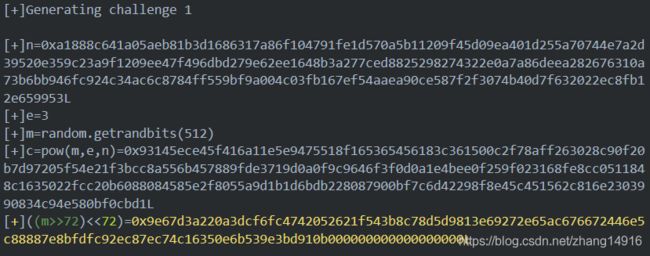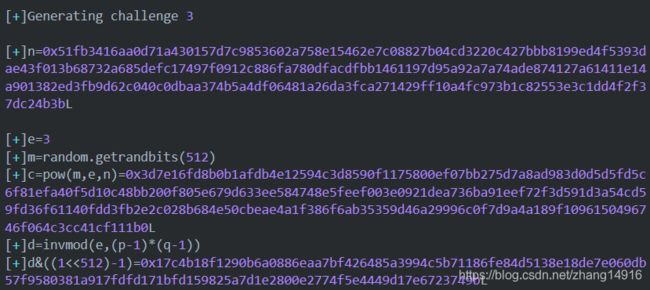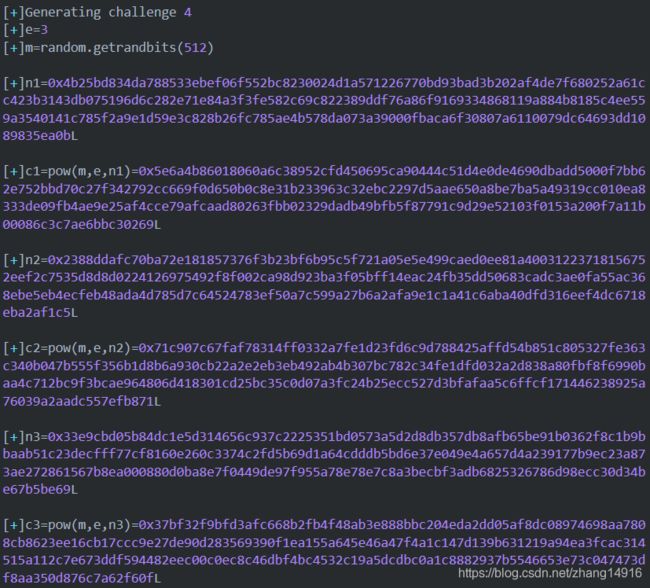强网杯
1.Coppersmith
最初进入需要暴力破解sha256的哈希值,然后之后将会有6个挑战,下面将找出6个challenge的解
challenge1:
我们可以看出这里已知m的高位,需要求m的低位,我们可以使用lll格算法求解
e = 0x3
b = 0x9e67d3a220a3dcf6fc4742052621f543b8c78d5d9813e69272e65ac676672446e5c88887e8bfdfc92ec87ec74c16350e6b539e3bd910b000000000000000000L
n = 0xa1888c641a05aeb81b3d1686317a86f104791fe1d570a5b11209f45d09ea401d255a70744e7a2d39520e359c23a9f1209ee47f496dbd279e62ee1648b3a277ced8825298274322e0a7a86deea282676310a73b6bb946fc924c34ac6c8784ff559bf9a004c03fb167ef54aaea90ce587f2f3074b40d7f632022ec8fb12e659953L
c=0x93145ece45f416a11e5e9475518f165365456183c361500c2f78aff263028c90f20b7d97205f54e21f3bcc8a556b457889fde3719d0a0f9c9646f3f0d0a1e4bee0f259f023168fe8cc0511848c1635022fcc20b6088084585e2f8055a9d1b1d6bdb228087900bf7c6d42298f8e45c451562c816e2303990834c94e580bf0cbd1L
kbits=72
PR. = PolynomialRing(Zmod(n))
f = (x + b)^e-c
x0 = f.small_roots(X=2^kbits, beta=0.5)[0]
print "x: %s" %hex(int(x0)) 这样我们就可以求出x0,然后求出m
challenge2:
我们可以看到我们已知p的高位,我们可以使用已知高位攻击求解p
n = 0x241ac918f708fff645d3d6e24315e5bb045c02e788c2b7f74b2b83484ce9c0285b6c54d99e2a601a386237d666db2805175e7cc86a733a97aeaab63486133103e30c1dca09741819026bd3ea8d08746d1d38df63c025c1793bdc7e38d194a30b492aadf9e31a6c1240a65db49e061b48f1f2ae949ac9e7e0992ed24f9c01578dL
p_fake = 0x2c1e75652df018588875c7ab60472abf26a234bc1bfc1b685888fb5ded29ab5b93f5105c1e9b46912368e626777a873200000000000000000000000000000000L
pbits = 1024
kbits = 130
PR. = PolynomialRing(Zmod(n))
f = x + p_fake
x0 = f.small_roots(X=2^kbits, beta=0.4)[0]
print hex(int(x0 + p_fake))
challenge3:
我们发现我们已知d的低位,我们可以使用Partial Key Exposure Attack。
#challenge3
def partial_p(p0, kbits, n):
PR. = PolynomialRing(Zmod(n))
nbits = n.nbits()
f = 2^kbits*x + p0
f = f.monic()
roots = f.small_roots(X=2^(nbits//2-kbits), beta=0.3) # find root < 2^(nbits//2-kbits) with factor >= n^0.3
#roots = f.small_roots(X=2^(nbits//kbits), beta=0.3)
if roots:
x0 = roots[0]
p = gcd(2^kbits*x0 + p0, n)
return ZZ(p)
def find_p(d0, kbits, e, n):
X = var('X')
for k in xrange(1, e+1):
results = solve_mod([e*d0*X - k*X*(n-X+1) + k*n == X], 2^kbits)
for x in results:
p0 = ZZ(x[0])
p = partial_p(p0, kbits, n)
if p:
return p
if __name__ == '__main__':
e = 3
n = 57569201048993475052349187244752169754165154575782760003851777813767048953051839288528137121670999884309849815765999616346303792471518639080697166767644957046582385785721102370288806038187956032505761532789716009522131450217010629338000241936036185205038814391205848232364006349213836317806903032515194407739
nbits = n.nbits()
kbits = floor(nbits*0.5)
print "kbits : ", kbits
d0 = 1244848677959253796774387650148978357579294769878147704641867595620534030329181934099194560059806799908134954814673426128260540575360296026444649631806619
print "lower %d bits (of %d bits) is given" % (kbits, nbits)
p = find_p(d0, kbits, e, n)
print "found p: %d" % p
q = n//p
# print d
print inverse_mod(e, (p-1)) challenge4:
我们已经有了三组对相同明文m使用e=3加密的密文,这里我们可以使用低加密指数广播攻击
n1=0x4b25bd834da788533ebef06f552bc8230024d1a571226770bd93bad3b202af4de7f680252a61cc423b3143db075196d6c282e71e84a3f3fe582c69c822389ddf76a86f9169334868119a884b8185c4ee559a3540141c785f2a9e1d59e3c828b26fc785ae4b578da073a39000fbaca6f30807a6110079dc64693dd1089835ea0b
c1=0x5e6a4b86018060a6c38952cfd450695ca90444c51d4e0de4690dbadd5000f7bb62e752bbd70c27f342792cc669f0d650b0c8e31b233963c32ebc2297d5aae650a8be7ba5a49319cc010ea8333de09fb4ae9e25af4cce79afcaad80263fbb02329dadb49bfb5f87791c9d29e52103f0153a200f7a11b00086c3c7ae6bbc30269
n2=0x2388ddafc70ba72e181857376f3b23bf6b95c5f721a05e5e499caed0ee81a40031223718156752eef2c7535d8d8d0224126975492f8f002ca98d923ba3f05bff14eac24fb35dd50683cadc3ae0fa55ac368ebe5eb4ecfeb48ada4d785d7c64524783ef50a7c599a27b6a2afa9e1c1a41c6aba40dfd316eef4dc6718eba2af1c5
c2=0x71c907c67faf78314ff0332a7fe1d23fd6c9d788425affd54b851c805327fe363c340b047b555f356b1d8b6a930cb22a2e2eb3eb492ab4b307bc782c34fe1dfd032a2d838a80fbf8f6990baa4c712bc9f3bcae964806d418301cd25bc35c0d07a3fc24b25ecc527d3bfafaa5c6ffcf171446238925a76039a2aadc557efb871
n3=0x33e9cbd05b84dc1e5d314656c937c2225351bd0573a5d2d8db357db8afb65be91b0362f8c1b9bbaab51c23decfff77cf8160e260c3374c2fd5b69d1a64cdddb5bd6e37e049e4a657d4a239177b9ec23a873ae272861567b8ea000880d0ba8e7f0449de97f955a78e78e7c8a3becbf3adb6825326786d98ecc30d34be67b5be69
c3=0x37bf32f9bfd3afc668b2fb4f48ab3e888bbc204eda2dd05af8dc08974698aa7808cb8623ee16cb17ccc9e27de90d283569390f1ea155a645e46a47f4a1c147d139b631219a94ea3fcac314515a112c7e673ddf594482eec00c0ec8c46dbf4bc4532c19a5dcdbc0a1c8882937b5546653e73c047473df8aa350d876c7a62f60f
e=3
n=[n1,n2,n3]
c=[c1,c2,c3]
print crt(c,n)
print n1*n2*n3from gmpy2 import *
r=877533165969611021300897177633332716450498688902896745502038181971110956394862214108039539480662343503196239826108192280616061455194554174380343866824408819488824543507816462156609968501505647968349611444049068546023641047050263313556826875803692668340893437832575291323877754675842428641851371151717079087479771817763240894112028562818508784899603268568287911320819376040119416607468298820935469987388428969412826336200028843070396225742771046786059599150109184
n=48003296261536058407814344942214828131887417878855542122782480853799717339808936995867531096087590270346432395645768979885848128339232421449770432227308763954357954533964930234867076400749113774003221373828500552853577617088618262967045988388080944077389447756337550814385831226751356097830049413918190076573809420867961651178869051141075589409612342729272755683649836048867123999174500277218081420374766415348443988479790461845991782921559626571981455734171647192870466681500990519380506853863882277389932269983947038391803055102409763349431204837244077667298366754697074121389389797552234045554441705252655424124285797465023326653927383012485415947384021275997124994584118311847374156537780860177070010453023118146327390308443479236561749633974706382715031943138386903914633631916117803815243591614453102499741276840183815359431231294993458810929835879676803765137929304321560428601728000695821426805869379067002953957327
k=0
while True:
i=r+k*n
k=k+1
if iroot(i,3)[1]:
print iroot(i,3)
break这样我们就算出了m
challenge5:
我们获得了m和m+1的密文,我们可以获得方程式![]()
![]() ,
,![]() ,我们只需求解方程即可
,我们只需求解方程即可
from gmpy2 import *
n=0x198f61bc7d2977139120b86b739afbd04e82726a7dcf514cc2ad46c7002d2202915ba932364d71b7dd1928fb6861f984d8d9e31e70d0023aca721130e1df2825568a623c8316fd555616d91897a2db5d1df973a1584ed4cfb0f55d910db5ff64a79f061ef71b2362b6c2af8416a5a47094aff428d6c541448df45436ec48f93L
c1=0x13a5213f8946b3da1b37a7346f7985ed17329b05c31cc72912e15ab62c2b578f95148f7f2fb3daed063f5517efd9694d8a87792b675715d50d9113baa0bbfb1791f8e551ce5583c3dc31adf37dced9dab4acf3e58a5f3e203b1c971a746de5e9ac0b4d0153538f9392a0ce12250c5597eb23f07b4d7c84a084fc1dd0dee6b1cL
c2=0xa864c9ffa08edc2d2a380fde218fe07204193c43580ee0a3fd1505e3f60125c3f380fab24bbd344bca174f3b5b09ed271b817cb08fa6087f2b9d2216a1c7782714c50f475b0e3ca8b530ae33f4f4fb72c14ac0331b107d9dfcbbb193ac6946edd01e9cf5cab799a444dd9a49eb5362f6a499fa69540ac1d3dfbb977f57cd8eL
e=3
for k in range(99999):
c=1-n*k+c1-c2
if 9-12*c>0:
delat=iroot(9-12*c,2)
if delat[1]:
x1=(-3+delat[0])/6
if pow(x1,3,n)==c1:
print x1
breakchallenge6:
这里我们发现e比较大,所以我们可以使用winner attack或者boneh and durfee attack
import time
############################################
# Config
##########################################
"""
Setting debug to true will display more informations
about the lattice, the bounds, the vectors...
"""
debug = True
"""
Setting strict to true will stop the algorithm (and
return (-1, -1)) if we don't have a correct
upperbound on the determinant. Note that this
doesn't necesseraly mean that no solutions
will be found since the theoretical upperbound is
usualy far away from actual results. That is why
you should probably use `strict = False`
"""
strict = False
"""
This is experimental, but has provided remarkable results
so far. It tries to reduce the lattice as much as it can
while keeping its efficiency. I see no reason not to use
this option, but if things don't work, you should try
disabling it
"""
helpful_only = True
dimension_min = 7 # stop removing if lattice reaches that dimension
############################################
# Functions
##########################################
# display stats on helpful vectors
def helpful_vectors(BB, modulus):
nothelpful = 0
for ii in range(BB.dimensions()[0]):
if BB[ii,ii] >= modulus:
nothelpful += 1
print nothelpful, "/", BB.dimensions()[0], " vectors are not helpful"
# display matrix picture with 0 and X
def matrix_overview(BB, bound):
for ii in range(BB.dimensions()[0]):
a = ('%02d ' % ii)
for jj in range(BB.dimensions()[1]):
a += '0' if BB[ii,jj] == 0 else 'X'
if BB.dimensions()[0] < 60:
a += ' '
if BB[ii, ii] >= bound:
a += '~'
print a
# tries to remove unhelpful vectors
# we start at current = n-1 (last vector)
def remove_unhelpful(BB, monomials, bound, current):
# end of our recursive function
if current == -1 or BB.dimensions()[0] <= dimension_min:
return BB
# we start by checking from the end
for ii in range(current, -1, -1):
# if it is unhelpful:
if BB[ii, ii] >= bound:
affected_vectors = 0
affected_vector_index = 0
# let's check if it affects other vectors
for jj in range(ii + 1, BB.dimensions()[0]):
# if another vector is affected:
# we increase the count
if BB[jj, ii] != 0:
affected_vectors += 1
affected_vector_index = jj
# level:0
# if no other vectors end up affected
# we remove it
if affected_vectors == 0:
print "* removing unhelpful vector", ii
BB = BB.delete_columns([ii])
BB = BB.delete_rows([ii])
monomials.pop(ii)
BB = remove_unhelpful(BB, monomials, bound, ii-1)
return BB
# level:1
# if just one was affected we check
# if it is affecting someone else
elif affected_vectors == 1:
affected_deeper = True
for kk in range(affected_vector_index + 1, BB.dimensions()[0]):
# if it is affecting even one vector
# we give up on this one
if BB[kk, affected_vector_index] != 0:
affected_deeper = False
# remove both it if no other vector was affected and
# this helpful vector is not helpful enough
# compared to our unhelpful one
if affected_deeper and abs(bound - BB[affected_vector_index, affected_vector_index]) < abs(bound - BB[ii, ii]):
print "* removing unhelpful vectors", ii, "and", affected_vector_index
BB = BB.delete_columns([affected_vector_index, ii])
BB = BB.delete_rows([affected_vector_index, ii])
monomials.pop(affected_vector_index)
monomials.pop(ii)
BB = remove_unhelpful(BB, monomials, bound, ii-1)
return BB
# nothing happened
return BB
"""
Returns:
* 0,0 if it fails
* -1,-1 if `strict=true`, and determinant doesn't bound
* x0,y0 the solutions of `pol`
"""
def boneh_durfee(pol, modulus, mm, tt, XX, YY):
"""
Boneh and Durfee revisited by Herrmann and May
finds a solution if:
* d < N^delta
* |x| < e^delta
* |y| < e^0.5
whenever delta < 1 - sqrt(2)/2 ~ 0.292
"""
# substitution (Herrman and May)
PR. = PolynomialRing(ZZ)
Q = PR.quotient(x*y + 1 - u) # u = xy + 1
polZ = Q(pol).lift()
UU = XX*YY + 1
# x-shifts
gg = []
for kk in range(mm + 1):
for ii in range(mm - kk + 1):
xshift = x^ii * modulus^(mm - kk) * polZ(u, x, y)^kk
gg.append(xshift)
gg.sort()
# x-shifts list of monomials
monomials = []
for polynomial in gg:
for monomial in polynomial.monomials():
if monomial not in monomials:
monomials.append(monomial)
monomials.sort()
# y-shifts (selected by Herrman and May)
for jj in range(1, tt + 1):
for kk in range(floor(mm/tt) * jj, mm + 1):
yshift = y^jj * polZ(u, x, y)^kk * modulus^(mm - kk)
yshift = Q(yshift).lift()
gg.append(yshift) # substitution
# y-shifts list of monomials
for jj in range(1, tt + 1):
for kk in range(floor(mm/tt) * jj, mm + 1):
monomials.append(u^kk * y^jj)
# construct lattice B
nn = len(monomials)
BB = Matrix(ZZ, nn)
for ii in range(nn):
BB[ii, 0] = gg[ii](0, 0, 0)
for jj in range(1, ii + 1):
if monomials[jj] in gg[ii].monomials():
BB[ii, jj] = gg[ii].monomial_coefficient(monomials[jj]) * monomials[jj](UU,XX,YY)
# Prototype to reduce the lattice
if helpful_only:
# automatically remove
BB = remove_unhelpful(BB, monomials, modulus^mm, nn-1)
# reset dimension
nn = BB.dimensions()[0]
if nn == 0:
print "failure"
return 0,0
# check if vectors are helpful
if debug:
helpful_vectors(BB, modulus^mm)
# check if determinant is correctly bounded
det = BB.det()
bound = modulus^(mm*nn)
if det >= bound:
print "We do not have det < bound. Solutions might not be found."
print "Try with highers m and t."
if debug:
diff = (log(det) - log(bound)) / log(2)
print "size det(L) - size e^(m*n) = ", floor(diff)
if strict:
return -1, -1
else:
print "det(L) < e^(m*n) (good! If a solution exists < N^delta, it will be found)"
# display the lattice basis
if debug:
matrix_overview(BB, modulus^mm)
# LLL
if debug:
print "optimizing basis of the lattice via LLL, this can take a long time"
BB = BB.LLL()
if debug:
print "LLL is done!"
# transform vector i & j -> polynomials 1 & 2
if debug:
print "looking for independent vectors in the lattice"
found_polynomials = False
for pol1_idx in range(nn - 1):
for pol2_idx in range(pol1_idx + 1, nn):
# for i and j, create the two polynomials
PR. = PolynomialRing(ZZ)
pol1 = pol2 = 0
for jj in range(nn):
pol1 += monomials[jj](w*z+1,w,z) * BB[pol1_idx, jj] / monomials[jj](UU,XX,YY)
pol2 += monomials[jj](w*z+1,w,z) * BB[pol2_idx, jj] / monomials[jj](UU,XX,YY)
# resultant
PR. = PolynomialRing(ZZ)
rr = pol1.resultant(pol2)
# are these good polynomials?
if rr.is_zero() or rr.monomials() == [1]:
continue
else:
print "found them, using vectors", pol1_idx, "and", pol2_idx
found_polynomials = True
break
if found_polynomials:
break
if not found_polynomials:
print "no independant vectors could be found. This should very rarely happen..."
return 0, 0
rr = rr(q, q)
# solutions
soly = rr.roots()
if len(soly) == 0:
print "Your prediction (delta) is too small"
return 0, 0
soly = soly[0][0]
ss = pol1(q, soly)
solx = ss.roots()[0][0]
#
return solx, soly
def example():
############################################
# How To Use This Script
##########################################
#
# The problem to solve (edit the following values)
#
# the modulus
N = 0xbadd260d14ea665b62e7d2e634f20a6382ac369cd44017305b69cf3a2694667ee651acded7085e0757d169b090f29f3f86fec255746674ffa8a6a3e1c9e1861003eb39f82cf74d84cc18e345f60865f998b33fc182a1a4ffa71f5ae48a1b5cb4c5f154b0997dc9b001e441815ce59c6c825f064fdca678858758dc2cebbc4d27
# the public exponent
e = 0x11722b54dd6f3ad9ce81da6f6ecb0acaf2cbc3885841d08b32abc0672d1a7293f9856db8f9407dc05f6f373a2d9246752a7cc7b1b6923f1827adfaeefc811e6e5989cce9f00897cfc1fc57987cce4862b5343bc8e91ddf2bd9e23aea9316a69f28f407cfe324d546a7dde13eb0bd052f694aefe8ec0f5298800277dbab4a33bb
# the hypothesis on the private exponent (the theoretical maximum is 0.292)
#delta = .18 # this means that d < N^delta
delta = .18
#
# Lattice (tweak those values)
#
# you should tweak this (after a first run), (e.g. increment it until a solution is found)
m = 4 # size of the lattice (bigger the better/slower)
# you need to be a lattice master to tweak these
t = int((1-2*delta) * m) # optimization from Herrmann and May
X = 2*floor(N^delta) # this _might_ be too much
Y = floor(N^(1/2)) # correct if p, q are ~ same size
#
# Don't touch anything below
#
# Problem put in equation
P. = PolynomialRing(ZZ)
A = int((N+1)/2)
pol = 1 + x * (A + y)
#
# Find the solutions!
#
# Checking bounds
if debug:
print "=== checking values ==="
print "* delta:", delta
print "* delta < 0.292", delta < 0.292
print "* size of e:", int(log(e)/log(2))
print "* size of N:", int(log(N)/log(2))
print "* m:", m, ", t:", t
# boneh_durfee
if debug:
print "=== running algorithm ==="
start_time = time.time()
solx, soly = boneh_durfee(pol, e, m, t, X, Y)
# found a solution?
if solx > 0:
print "=== solution found ==="
if False:
print "x:", solx
print "y:", soly
d = int(pol(solx, soly) / e)
print "private key found:", d
else:
print "=== no solution was found ==="
if debug:
print("=== %s seconds ===" % (time.time() - start_time))
if __name__ == "__main__":
example()
2.randomstudy
题目中有三轮,第一轮只需要预测random运行时间,第二轮需要查看java的random如何生成,在进行匹配,第三轮可以使用randcrack预测python的随机数,代码如下:
import java.io.PrintStream;
import java.util.Random;
import java.util.concurrent.atomic.AtomicLong;
public class test
{
public static long nextSeed(long seed){
return ((seed * 0x5DEECE66DL + 0xBL) & ((1L << 48) - 1)) ;
}
public static int getNextInt(long seed, long bits ){
return (int)(seed >>> (48 - bits));
}
public static void main(String[] paramArrayOfString)
{
long t1 = Long.parseLong(paramArrayOfString[0]);
long t2 = Long.parseLong(paramArrayOfString[1]);
for(int i=0; i< 0x10000; i++){
if( t2 == getNextInt(nextSeed((t1 << 16) + i), 32)){
// System.out.println("find:");
// System.out.println(getNextInt(nextSeed((t1 << 16) + i), 32));
System.out.println(getNextInt(nextSeed(nextSeed((t1 << 16) + i)),32));
}
}
}
}import hashlib
import random
import time
import subprocess
from randcrack import RandCrack
from pwn import *
def proof(skr, skr_sha256):
for c1 in range(0x100):
for c2 in range(0x100):
for c3 in range(0x100):
shr = skr + chr(c1)+ chr(c2)+ chr(c3)
# print hashlib.sha256(shr).hexdigest()
if hashlib.sha256(shr).hexdigest() == skr_sha256.strip().lower():
print shr.encode("hex")
return shr.encode("hex")
def one(p, t):
random.seed(t)
randintdata = str(random.randint(0,2**64))
print "Try: ", randintdata
p.sendline(randintdata)
i = -10
time_num = 1
data = p.recvline()
print data
while "fail" in data:
time_num += 1
random.seed(t + i)
for x in range(time_num):
randintdata = str(random.randint(0,2**64))
print "Try: ", randintdata
p.sendline(randintdata)
i += 1
data = p.recvline()
if i == 8:
print "attack fail!"
exit()
def second(p, x1, x2):
x1 = x1.strip()
x2 = x2.strip()
print x1,x2
o = subprocess.check_output(["/usr/lib/jvm/jdk-12.0.1/bin/java", "test", x1, x2])
while len(o.split('\n')) == 1:
p.sendline("1")
p.recv()
print p.recvuntil("[-]")
data1 = p.recvuntil("\n").strip()
p.recvuntil("[-]")
data2 = p.recvuntil("\n").strip()
o = subprocess.check_output(["/usr/lib/jvm/jdk-12.0.1/bin/java", "test", data1, data2])
print "output:", o.split('\n')
p.sendline(o.split('\n')[0])
p.recv()
def third(p):
rc = RandCrack()
for i in range(624):
p.sendline("1")
oneline = p.recvline()
print i, int(oneline[10:-1])
this_num = int(oneline[10:-1])
rc.submit(this_num)
p.recvuntil('[-]')
this_num = rc.predict_randrange(0, 4294967295)
p.sendline(str(this_num))
print p.recv()
print p.recv()
print p.recv()
def attack():
p = remote("119.3.245.36", 23456)
p.recvuntil("hexdigest()=")
skr_sha256 = p.recvuntil("\n")
p.recvuntil("('hex')=")
shr5 = p.recvuntil("\n").strip().decode("hex")
p.recv()
p.sendline(proof(shr5, skr_sha256))
p.recv()
p.sendline("bfdccbebf86687951f6d37b3e5a35fe1")
p.recv()
p.recv()
one(p, int(time.time()))
# print p.recvuntil("[-]")
print p.recvuntil("[-]")
data1 = p.recvuntil("\n")
p.recvuntil("[-]")
data2 = p.recvuntil("\n")
second(p, data1, data2)
print p.recv()
p.recv()
third(p)
attack()





